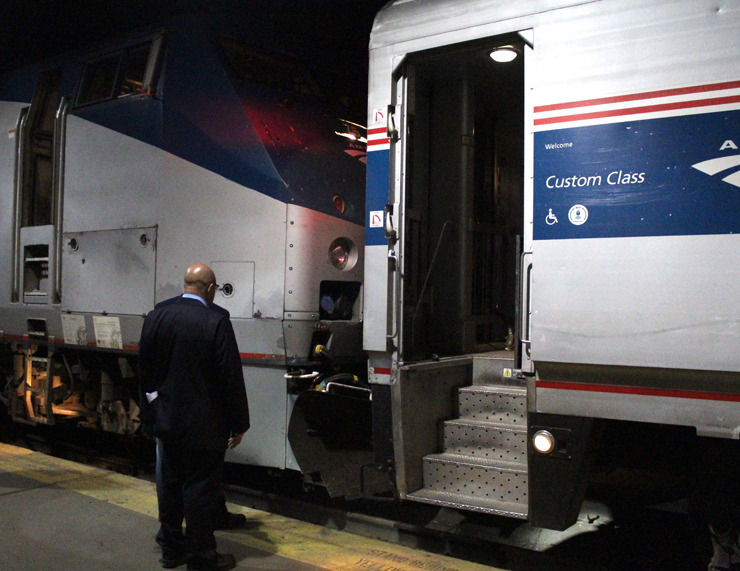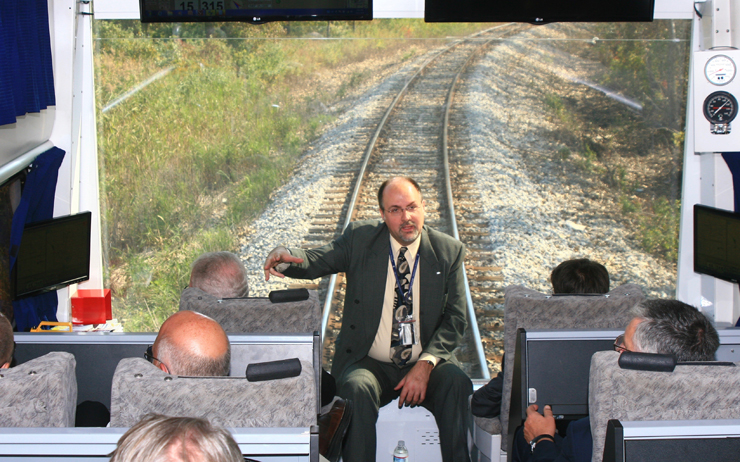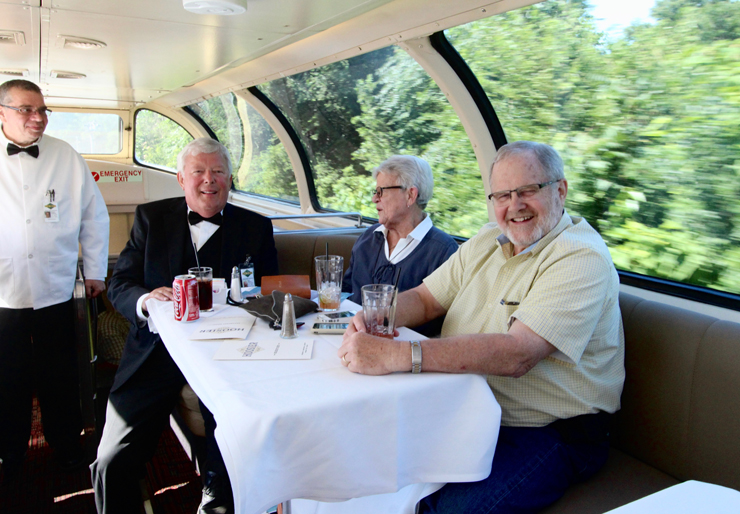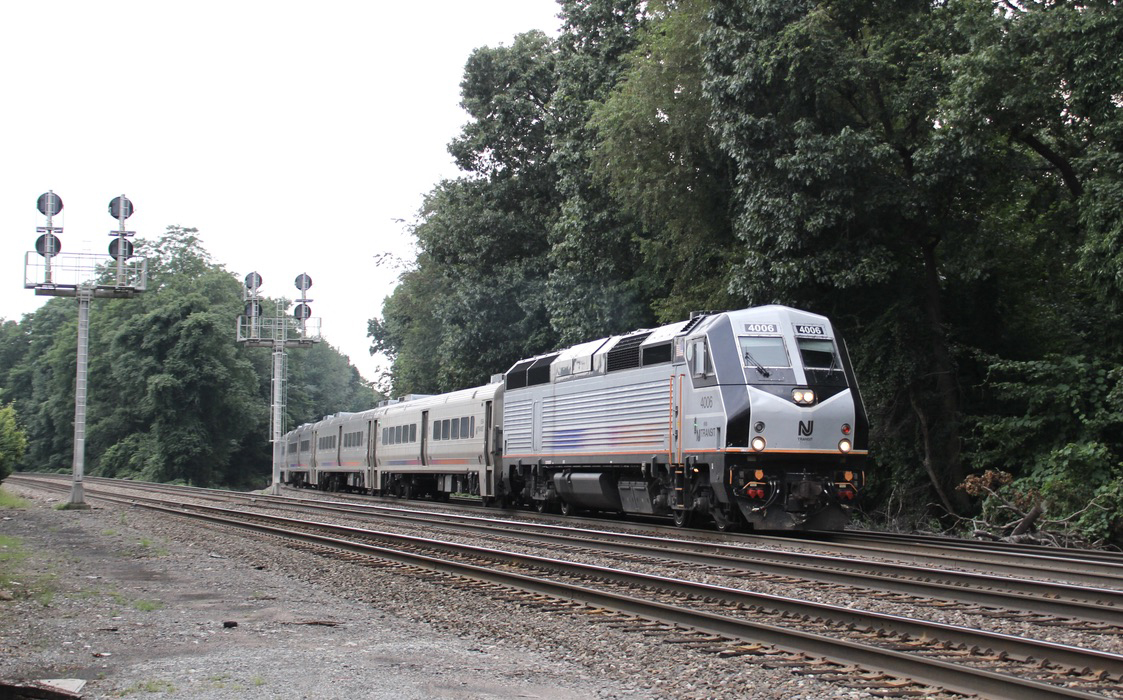INDIANAPOLIS — Indiana Gov. Eric Holcomb issued the Chicago-Indianapolis Hoosier State’s official death warrant this week when he signed a $34 billion state budget approved by the state legislature. It fails to include a $3 million operating grant in each of the next two fiscal years that would have maintained daily service on a route also served by Amtrak’s tri-weekly Chicago-New York Cardinal.
The Hoosier’s last runs are set for Sunday, June 30.
The signing effectively ends efforts to keep the train running by a bipartisan group of legislators and local politicians at intermediate Hoosier State stops of Rensselaer, Lafayette, and Crawfordsville. Those communities — but not Indianapolis — have collectively contributed about $500,000 annually to support the service.
The discontinuance will end the train’s complex tale of funding and operational struggles.
In 2013, Indiana initially balked at providing an operating grant under Section 209 of the Passenger Rail Investment and Improvement Act of 2008, which requires states to fund the majority of routes operating under the legislation’s arbitrary 750-mile demarcation.
Amtrak management helped Congress craft the law’s “short distance” versus “long distance” dichotomy. The distinction was based on the political reality that North Carolina was already paying operating support for the 704-mile New York-Charlotte, N.C., Carolinian, but politically conservative South Carolina and Georgia state governments would not agree to fund the 829-mile New York-Savannah, Ga., Palmetto, the only Amtrak long-distance train that doesn’t run overnight.
The goal was to get states with robust corridor service such as Michigan, New York, and Virginia — where Amtrak had historically provided full funding — to pay for trains on the same basis as other states, as well as operating authorities from California to Maine.
However, in no way did the Hoosier State resemble or impose the same kind of cost burden on Amtrak as those multi-frequency corridors. But its board of directors and management under then-President Joe Boardman never fought for an exemption that would have been justified, based on the fact that the Hoosier served two unique functions: It facilitated a daily link from Chicago to the company’s indispensable Beech Grove Heavy Maintenance Facility near Indianapolis, and it strengthened the Cardinal’s role as a meaningful Chicago-Indianapolis corridor service by filling the void on days the long-distance train didn’t operate.
Amtrak also declined to pursue with host railroads a key finding of the legislation’s required Section 210 “Performance Improvement Plan,” which concluded that efficiencies and increased revenue accruing from daily Cardinal operation would be only marginally more expensive than the status quo. The proposal argued that a required third Chicago-New York trainset could be largely assembled from the Hoosier’s equipment, which deadheads with the Cardinal on two trips and is idle on Thursdays and Saturdays.
Instead, Amtrak’s sanctimonious stance to Indiana was, “to be fair to the other states, you have to pay.” Thus, funding was in the hands of a state government that focused on the train’s revenue and expenses, rather than embracing the mobility benefits or transportation value that intercity rail can provide — even if the communities it served did recognize that value.
This sent the train on a tortured path that included:
— A failed attempt to strike a deal in mid-2014 with Corridor Capital, LLC., “America’s first passenger train development company” (as described in its slick brochure at the time) that would use leased passenger cars and locomotive. Indiana apparently didn’t realize it was expected to bankroll new equipment acquisition.
— Interim operation by Amtrak beginning in October, 2014, coupled with efforts by management to explain the route’s inherent weaknesses and opportunities to both the state DOT and communities. It was similar to the effort to stir up support and funding for the Southwest Chief. But unlike officials in Kansas, Colorado, and New Mexico, those in Indiana not only refused to ride the Oct. 1 inspection train and meet with CSX officials on board, but never took applied for external funding. Their attitude: We don’t know and we don’t want to know.
— A deal with Iowa Pacific Holdings, starting Aug. 2, 2015, for marketing and enhanced onboard service upgrades like business class, a dome car, and full dining service, in contrast to the bare-bones, coach-only service Amtrak had provided. However, the contract allowed Amtrak, which supplied operating crews, insurance, and facilitated the state’s right of access, to be paid first. Despite increased patronage, customer satisfaction, and revenues, Iowa Pacific couldn’t cover the increased expense, so it pulled out at the end of February 2017.
— Another try by Amtrak from March 2017 to the present, this time adding business class, Wi-Fi, and a cafe car. But marketing efforts disappeared, hastened by Amtrak management changes that didn’t include efforts to increase revenue in the business plan.
Through all these gyrations, Indiana — with or without Amtrak’s assistance — never made any meaningful attempt to find money for CSX infrastructure improvements. Such upgrades might pave the way for reduced travel times and another round trip, which might coax Indiana residents off of dangerous and congested Interstate 65. The state did commission at least one engineering study that outlined route enhancement options, but current Indiana DOT spokesman Scott Manning told Trains News Wire in January 2019 that he wasn’t aware that the documents ever existed. They certainly were never acted upon.
Officials focused only on passengers actually carried, 27,878 in fiscal 2018, rather than the 60,000 Amtrak determined who traveled on either the Cardinal or Hoosier State. Now, most of that business will be lost to the reality of inconvenience.
“A lack of frequencies on a corridor ripe for development like this one effectively doubles the price,” a former Amtrak operations manager tells Trains News Wire, because revenue derived from an extra round trip with the same equipment would spread fixed and variable costs over more revenue-producing trips. He adds, “I don’t think anyone put a good plan in front of the state.” Unfortunately, Amtrak’s still-opaque allocated-cost formulas for equipment and administrative charges don’t encourage additional frequencies either.
Other ironies:
— The governor’s axe fell the same week Amtrak touted its 48th anniversary on May 1 by noting in a press release that the company “is heading toward break-even on an operating earnings basis by [fiscal year 2021]” and “has committed to investing billions in modernizing infrastructure, fleet, and facilities to meet the growing needs and ensure a continued, bright future for passenger rail service across the nation.” Except, that is, for the Hoosier State in Indiana.
— The state legislature and Gov. Holcomb’s decision was finalized during the public comment period for the Indiana Department of Transportation’s “Statewide Transportation Improvement Program.” The DOT is soliciting suggestions for surface transportation projects, “in which construction and operating funds can reasonably be expected to be available.” Respondents can offer their opinions here or at one of 11 open-house dates through May 16. The only one scheduled for a community directly on the route of the Hoosier State/Cardinal is May 9, at Oakland High School in Lafayette, Ind., from 5-7 p.m.
Perhaps a number of interested constituents may attend, but it will be too late to save daily service.

















Charles – Neither Rochelle nor Milwaukee is a hub for Amtrak and neither is much closer to Chicago than Indianapolis is. Do you think any sane company would relocate its facilities and machinery and its people to be forty or so miles closer to Chicago than Indianapolis is?
By the way, Rochelle is nowhere near an Amtrak route and northwestern Milwaukee means trackage rights over railroad lines Amtrak doesn’t use.
We can’t solve Amtrak’s problems with off-the-wall suggestions.
I suspect there are several places in “Chicagoland” that could host a maintenance facility to replace Beech Grove. I believe Amtrak’s current “footprint” (property, facilities, etc.) is too large for the business Amtrak does in Chicago. Moving Beech Grove to an underused facility would improve property utilization as well as put the shop at the hub of the Amtrak LD network. Along the line, Amtrak should sell Chicago Union Station (CUS) to Metra. Amtrak is the owner but the minority operator in CUS.
The Talgo plant in Milwaukee did open. Built two trainsets, then closed. It was reopened and is now working on rebuilding LA Metro’s 1980s vintage Breda Red Line rolling stock.
I think the Governor of Indiana is a dishonest conniving and sneaky S.O.B.
If the stituation gets out of hand and Amtrak closes Beech Grove and moves operations closer to Chicago as some here in these comments have suggested there a few underused facilities that come to mind. One the now closed Nippon Shayro plant near Rochelle Il. Another one that comes to mind is the never opened Talgo facility in Milwaukee. There might be other sites closer that are closed or underutilised that Amtrak can take a look at.
This article’s analysis is wrong on two important counts:
1. PRIIA Sec. 209 does NOT require states (or others) to pay for Amtrak’s make-believe “losses” on trains under 750 miles. All it requires is that Amtrak come up with a uniform method of calculating costs for state-sponsored trains. That Amtrak conned states into paying for trains like this under PRIIA 209 is a national shame. The con is still going on, too, since Amtrak’s (only) route accounting system (APT) is still incapable of calculating “avoidable costs” so whatever they choose to charge Indiana is NOT the incremental cost of the service, less revenues.
2. The Hoosier State was put on initially by Amtrak as a national system, fully-federally funded, service. It was done to provide a shuttle to Beech Grove for equipment needing maintenance. Now, Amtrak has shot itself in the foot and will have to limit these moves to the Cardinal, with the attendant costs and delays associated with adding and dropping cars headed to or fro the shops (the very same reason they cited for refusing most private car moves).
The basis of your opinion Mr. Cox is what?
By the end oft the summer the paltry 27,000 annual riders of the Hoosier State will have moved on to more efficient and faster modes of transportation and few will even notice its gone and even fewer will care. Good riddance. Now lets move on to other waste of money trains that don’t carry enough passengers to justify their subsidy and get rid of them so we can save Amtrak.
As many are aware there is this philosophical argument about what exactly Amtrak should consist of outside of the NE corridor. Amtrak does not like operating intrastate routes unless the state themselves put up some serious dough to make it happen.
Bankrupt Illinois puts up the dough to keep certain intrastate routes available, like Chicago to Quincy. When IDOT started looking at a Chicago-Rockford route, the first question was, who is going to operate it, Amtrak or Metra? (Metra was the preferred operator of choice)
A Chicago to Indy service with high frequency has a good biz case if done properly. But there is most definitely a “anti-transit subsidy” in the lower parts of the state. (Everything south of South Bend) A recent transit initiative in greater Indy had mass appeal, but was undercut by a quiet, yet powerful lobby. The same lobby has been providing the below the surface friction to the Hoosier State for awhile.
I agree that Beech Grove should provide a level of impetus for Indiana politicos, but with this lobby in place locally, I would move Beech Grove operations closer to Chicago where the needs are most prevalent. No more dead heads, no more special moves. Get the operations out of Indiana and closer to where the action is.
Bravo to my native state! The Cardinal needs to go next!
The only place Amtrak will ever be a reliable source of transportation is the NE corridor.
Great article and summary of the saga Bob. Thank you.
Did Amtrak ever fully compensate Indiana for hauling deadhead cars to and from the Beech Grove shops on the HOOSIER STATE?
More has to happen than making the CARDINAL a daily train. Investments need to be made to increase the velocity of the train between Indianapolis and Chicago. The CARDINAL/HOOSIER STATE’s current route is 196 miles long, compared with the former MONON “airline” route of 184 miles and the former IC/NYC “Big Four” route of 194 miles (The Official Guide, July 1956). However, the HOOSIER STATE averages 39MPH compared to the TIPPECANOE (Monon) at 46MPH and the JAMES WHITCOMB RILEY (IC/NYC) at 57MPH. That will require funding from Indiana and CSX.
Regarding the Hoosier State’s schedule, which practically everyone agrees is inconvenient: why was it necessary that this train run on the identical schedule as the Cardinal? Who knows what ridership would have been if the Hoosier State, even four days week, had operated at more convenient times? Why was this train “locked into” the Cardinal’s inconvenient schedule?
One obvious solution would be to make the Cardinal a daily train.
If the Hoosier State is the best we can do, that schleppediche train no one rides, then you really have to wonder about this country.
I totally agree with Mr. Ash!
Agree with the fact that corridor trains should absolutely, positively live and die by state funding. Indiana made its decision whether we agree or not, you have to respect what the state thinks is best for the Chicago to Indy corridor. Where as other states think differently, Capital Corridor is reporting 5% month over month growth because of state support and clogged California freeways. I support it because I spent plenty of hours sitting in I80 traffic on way to and from Sacramento out of the Bay Area and it will take a lot of money to add more lanes. Where as, Minnesota should decide and put up the funds or shut up if it truly wants a corridor train to Duluth from Twin Cities or heck, a north south corridor from Rochester to Duluth running through Twin Cities as secondary commuter service. And so on.
I also think Amtrak needs to move Beech Grove out of Indiana or at least to the north to be more inline with national network. Getting the benefit of federal dollars and jobs to support Amtrak but not willing to support an Amtrak corridor train is not reasonable either. So I say its time that Beech Grove facility ops move to the Chicago area, whether it is on Wisconsin side or Illinois side side of the state border, or St Louis area, or so on
I also agree with the obvious answer for national network that Cardinal should be a daily train. But Congress also needs to step up investment in national trains for some needed daily and more frequent service, whether it be Cardinal or a second empire builder, so on. This whole we want the service such as in the Chief from both side of the political spectrums feeding it crumbs is getting old.
Finally, I do think it is time for NEC to separate and be standalone. Require full access from National Amtrak and in return give NEC access to Portland ME to the north as well as Richmond & Hamptron Roads VA to the south. Let NEC pursue separately its needs and priorities whether it be Hudson River tunnel, NJ bridges, Baltimore tunnel, additional capacity across Potomac River into Virginia and even tying Boston south and north stations together finally. That also give NEC better ability to negotiate with all the commuter trains plying the rails and no more hiding true costs with the messed up accounting. Wilmington facilities become NEC only and Beech Grove (or anew Midwest facility) becomes National Amtrak only.
The political vehicle to make it all happen is the proposed infrastructure plan that the respective parties are talking about. Go big or get voted to go home. We should be making investments now when the economy is good.
Right on target Mr. Ash.
Indiana gets something – Amtrak’s Beech Grove Shop – for nothing – not contributing to the costs of Chicago – Indianapolis service. That’s not sustainable long term. Given the current funding rules, if Indiana wants Beech Grove, they’re going to need to pony up for a Chicago – Indianapolis train.
If just the NEC is the sole goal and reality of Amtrak, as a taxpayer count me out. Shut the whole thing down. The loss of the Hoosier State is essentially due to financial and operational neglect. For the naysayers of the HS, maybe they have not driven from Chicago and connecting to I 65. It is an utter mess and building more highways is not going to cut it. I thought Anderson said corridors were the future of Amtrak. He is a fraud like most of his management team and those involved in the state of Indiana. The HS situation is indicative of an intermodal transportation policy and Amtrak indifference.